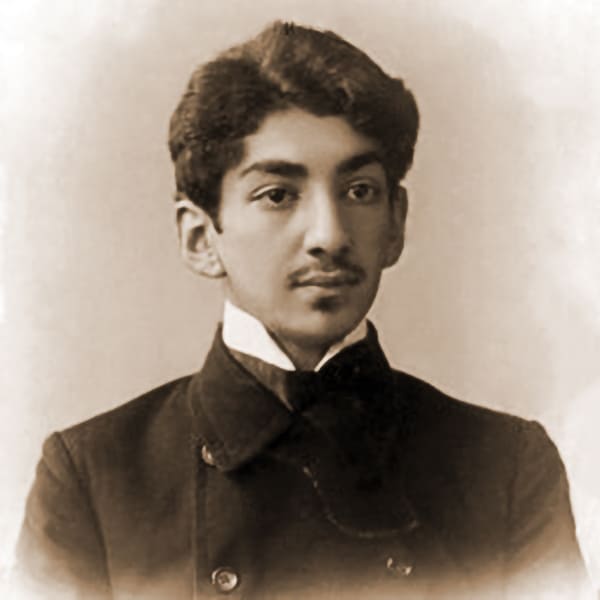Death of Georgy Yakulov (December 28, 1928)

Georgy Yakulov (Yakulian) had a brief life but was an influential artist in Russia in the 1910s and the Soviet Union afterwards. Also well-known in the West, he put his talents as painter, graphic artist, and set designer to the service of avant-garde innovation.
He was born on January 14, 1884, in Tiflis, the ninth child in the family of a famous lawyer, Bogdan Yakulov (Astvatzatur Yakulian). His father passed away in 1893 and his mother took the children with her and moved to Moscow. Georgy entered the boarding school of the Lazarian Institute of Oriental Languages but was expelled from sixth grade in 1898 for disobeying the boarding school rules.
He showed interest in art and, after two months of classes, he entered the Moscow school of painting, sculpture, and architecture in 1901. However, he was expelled from the painting department in May 1903 for failure to attend the classes. He was drafted into the army and served in the Caucasus and the Russo-Japanese war. He was wounded in 1905 and returned to Moscow.
His first exhibitions in 1906-1907 attracted the attention of critics. In 1907 he became close to the artists of the Blue Rose group, which included Martiros Sarian. He also took his first steps in architectural decoration and book graphics. His works were shown in Moscow and Vienna, and after a trip to Italy in 1908, he spent a long time in Paris in 1911-1913. In January 1914 was one of the co-writers of the manifesto “We and the West,” released in Russian, French, and Italian. In the same year, in an essay entitled “Blue Sun,” Georgy Yakulov outlined for the first time his artistic theory of “multi-colored suns,” which he would fully develop in 1922.
Yakulov participated in World War I between 1914 and 1917, when he was discharged with the rank of staff captain. His innovative work on the design of the Moscow artistic café “Pittoresque” (1917-1918) became one of the highlights of his artistic career and put him under the spotlight. He taught at the First Free State Art Workshops in 1918-1920. He moved closer to a group of imagist writers and artists, which included his friend Sergei Esenin, the great Russian poet, and signed a “Declaration” in January 1919, which stated the “death of futurism.” Yakulov married Natalia Shif in 1920.
Georgy Yakulov’s most productive stage in his creative activity was his work as a theater artist. He took part in twenty productions of Moscow theaters between 1918 and 1926, and was so omnipresent that critics wrote about the “yakulovization of theater” in 1923. He also stepped into architectural construction and created a project for a monument to the 26 Baku Commissars in 1923-1924, in collaboration with V. Schuko.
After his paintings were exhibited in Berlin and Paris in 1922-1923, Yakulov participated in the World Fair of Paris (April-October 1925) with models of the monument to the Baku commissars and theatrical scenery. He was elected vice-president of the jury for the theater section and jury member for the architecture section. His works were awarded honorary diplomas out of competition. His fame and recognition as a set designer was so high that Yakulov received an offer from Sergei Diaghilev, the world-famous director of the Ballet Russes, to participate in the creation of a ballet about the life of modern Russia, “Steel Gallop,” for which he worked on sketches of scenery and costumes, as well as the libretto with composer Sergei Prokofiev. The ballet was performed in Paris and London.
Among the designs of Yakulov, there were several performances carried out in Baku, Yerevan, and Tbilisi. In October 1926, he participated in the jury for the competition projects of the People’s House and stayed in Armenia and Georgia for a long time. In late 1926-early 1927, he worked on the design of four simultaneous performances: the plays “The Merchant of Venice” (William Shakespeare) and “Morgan’s In-Law” (Alexander Shirvanzade) in Yerevan and two musical works in Tbilisi.
Preparations for the twenty-fifth anniversary of Yakulov’s creative activities were underway in 1928, but Yakulov’s tuberculosis was in progress, and in August 1928 he went to Dilijan, Armenia, for treatment. He made a series of landscape sketches and wrote two programmatic articles: “Theater and Painting” and “Revolution and Art.” In November, Yakulov caught a cold and fell ill with pneumonia. He passed away in Yerevan, where he had been admitted to the hospital, on December 28, 1928. The upcoming jubilee celebration became a civil funeral service, and the coffin was sent by a special funeral carriage to Moscow.
Yakulov was buried on January 7, 1929, at the Novodevichy cemetery. His works were not found in his studio, and neither was his archive. A hundred paintings he had left with painters Mikhail Larionov and Natalia Goncharova in Paris went to their heirs, and some of them were donated to the Tretyakov Gallery in Moscow, and others bought from Larionov’s heirs by the Society of Friends of Georgy Yakulov and donated to the Art Gallery of Armenia. Other paintings are in museums of Paris and Russia or in private collections; the same is true of most of his theatrical designs. The main set of documents and photographs about the life and work of Georgy Yakulov are kept in the National Art Gallery of Armenia, and the first retrospective exhibitions were organized in 1959, 1967, and 1975 in Yerevan.
